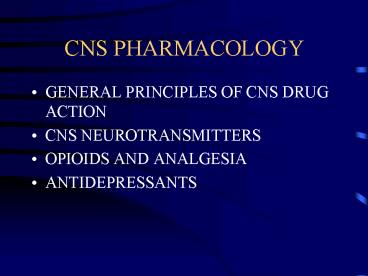CNS PHARMACOLOGY - PowerPoint PPT Presentation
1 / 10
Title:
CNS PHARMACOLOGY
Description:
BBB - lipid soluble drugs pass through. Most CNS drugs ... (amphetamine) CNS NEUROTRANSMITTERS. Mainly excitatory: - glutamate ( in epilepsy) - ACh ( in AD) ... – PowerPoint PPT presentation
Number of Views:663
Avg rating:3.0/5.0
Title: CNS PHARMACOLOGY
1
CNS PHARMACOLOGY
- GENERAL PRINCIPLES OF CNS DRUG ACTION
- CNS NEUROTRANSMITTERS
- OPIOIDS AND ANALGESIA
- ANTIDEPRESSANTS
2
GENERAL PRINCIPLES
- CNS drugs most frequently used type
- Therapeutic as well as social use
- (?
well-being) - BBB - lipid soluble drugs pass through
- Most CNS drugs modify synaptic processes
3
ADAPTATION TO DRUG USE
- Neuroadaptation may occur with prolonged drug
exposure - a) Therapeutic effects ? - eg antidepressants
- b) Tolerance -to therapeutic and/or side
-
effects - need to progressively ?
dose to - produce the original
effect
4
TOLERANCE
- Mechanisms include ? drug metabolism, ? receptor
numbers or activity (homeostatic) - May ? physical and possibly psychological
dependence - Withdrawal ? rebound activity, eg
- depressant withdrawal
seizures - (alcohol, barbiturate)
- stimulant withdrawal
depression - (amphetamine)
5
CNS NEUROTRANSMITTERS
- Mainly excitatory
- - glutamate (? in epilepsy)
- - ACh (? in AD)
- Mainly inhibitory
- - opioid peptides (? effects for analgesia)
- - GABA (?to treat epilepsy, anxiety,?sleep)
- - dopamine (? for PD, ? for schizophrenia)
- - NA and 5-HT (? to treat depression)
6
OPIOID ANALGESICS
- Multiple receptor subtypes (inhibitory)
- Agonist ? ? pain sensation (? substance P)
- ? suffering (limbic cortex)
- Morphine-like agonists include codeine and heroin
- Synthetic agonists - pethidine, fentanyl and
methadone-like drugs - Antagonist at all receptor types naloxone
7
UNWANTED EFFECTS OF OPIOID ANALGESICS
- ? respiratory centres in medulla
- constipation (GIT), nausea (CTZ)
- pupillary constriction, cough suppression
- morphine ? histamine release ? hypotension,
bronchoconstriction - tolerance develops quickly (no cross-tolerance to
CNS depressants) - abuse (less with treating pain) ? physical,
psychol. dependence (abstinence syndrome)
8
DEPRESSION
- Extremes of mood
- mania (high) depression
(low) - - major depression unrelated to life events
- - bipolar disorder manic-depressive illness
- Antidepressant drugs
- Action - ? NA and serotonin (5-HT) in brain
(monoamine hypothesis of depression)
9
ANTIDEPRESSANT DRUGS
- 3 Main drug types
- TCAs - block reuptake of NA 5-HT
- MAO inhibitors - block breakdown of NA and 5-HT
by enzyme MAO - Selective 5-HT reuptake blockers (SSRIs)
- eg fluoxetine (Prozac)
- Antidepressant effects take 1-3 weeks
- (? neuroadaptive changes)
10
ANTIDEPRESSANTS
- Irreversible MAOIs can cause a hypertensive
crisis due to NA release by dietary tyramine (in
cheese, avocados, fermented meats) - ECT may be used for more rapid treatment effects,
or where drugs are not successful - Bipolar disorder - stabilised by lithium
- ( antipsychotic or antidepressant if needed)
- - monitor plasma levels - toxicity































